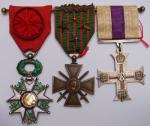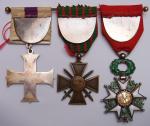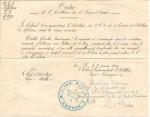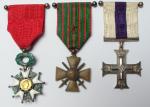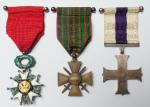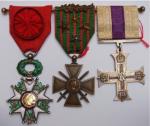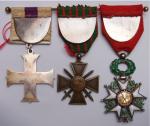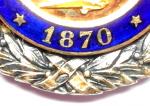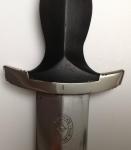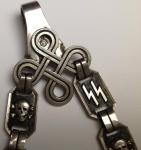-
Posts
402 -
Joined
-
Last visited
-
Days Won
2
Content Type
Profiles
Forums
Blogs
Gallery
Events
Store
Everything posted by Bison
-

France unknown medal on a medalbar from a german legionnaire
Bison replied to dedehansen's topic in France
This is the medal of "prisonniers civils, déportés et otages de la Grande Guerre" (Civilian prisoners, displaced persons and hostages of the Great War), created in 1936. Impossible for a military award. Possible for civilians living in the French territories invaded by the Germans in 1914-1918. Regards Bison -
Thanks Vétéran. Yes, TacHel, I was lucky. This is the second 'French' MC group I found. The first one is unfortunately anonymous. But I keep hope to put a name on it. The first of my collection is an Officer of the Légion d'honneur, Croix de Guerre with 5 mentions (one palm, four stars), and the MC. http://gmic.co.uk/uploads/monthly_04_2014/post-2068-0-01278500-1398877796.jpghttp://gmic.co.uk/uploads/monthly_04_2014/post-2068-0-27620600-1398877824.jpg Just as an illustration, I love this picture: Cheers Bison
-
Discovered some months ago, this very interesting group of Capitaine Charles Costes. From August 1914 to March 1916, he is in the Somme with the 9th Artillerie regiment. He is awarded the Croix de guerre in January 1916. Then, he is posted to the 1st Artillery Regiment from March 1916 to November 1916. He took part to the whole first Somme Battle with its unit attached to the British Forces. He is awarded the Military Cross on the 25th of August 1916. This is the French paper telling he received the MC: Then, he joined the 87th Artillery Regiment up to the end of the war. He is awarded the Légion d'honneur on the 30th of April 1918. The most extraordinary in this story is that he survived the entire First World War. Cheers Bison
-
OK, let's try to explain the values I gave before for the trio shown by Noor. TacHel, the clasps you are showing are all but clasps for the Colonial medal. Only the gold-colored ones are for the Oversea Medal which has replaced the Colonial medal in the 60s. All are modern made, and in common metal. Back to the Noor's trio. What do we actually have? First, we have the Madagascar second campaign medal, awarded in 1894-1895. It looks like it is an original one from the period of creation. Note it has been made during a long time after the first awards. Second, we have the Dahomey Campaign medal created for a particular expedition in 1892. It exists various versions and late productions which differ by some details from the early production. From what I see, this is most likely one is from the early production. Third, we have the Colonial medal, first official type, issued between 1895 and 1913. On this colonial medal we have two clasps in silver (head of boar stamp). They have been made by Lemaitre, who was a famous medal maker on that period. The two clasps present the characteristics of his early production, circa 1895 - 1900. The clasp "MADAGASCAR" has been awarded for campaigns between 1896 and 1900, or between 1903 and 1906. The clasp "COTE D'IVOIRE" has been awarded for campaigns between 1893 and 1900. These two clasps have been produced during a long period after the campaigns, but they are different. So what ? 1. These 3 medals are fully compatible together, issued during the period of award, therefore they can come from the same soldier. 2. To obtain these 3 medals, this soldier has probably: - done the Dahomey Campaign in 1892 (Dahomey Campaign Medal) - then shifted in Ivory Coast Campaign in 1893 (Colonial Medal with "Côte d'Ivoire" clasp) - then deployed in Madagascar circa 1894 - 1895 (Madagascar Second Campaign Medal) - and remained in Madagascar in 1896 + (Colonial Medal with clasp "Madagascar") 3. All these original early issued medals are relatively scarce 4. If they come from the same group, this would be a very interesting combination... but unfortunately we will probably never know. Regards Bison
-
Timo, The clasps are from Lemaitre. TacHel, if you want to share with us your magic box... Bison
-
Hi Noor, This just my humble opinion. Madagascar medal: the clasp is missing, this is 50% value off. Pending the Monnaie de Paris stamp, if it is not from the period, it is more 20% off. A full good one is about 90 euros. Dahomey, pending further examination, this is something around 200 euros, I let you translate in GBP. There are some copies. Colonial medal is all about the clasps in this case. These are relatively scarce. They seem to be well marked. Let say again something around 300 euros, pending further examination on hands. Again, this is my personal approach if I would be in position to buy, as a starting point. Regards Bison
-
Nice attribution ! We are some few collectors in France tracking the 'funny' attributions on medals... I have a labour medal attributed to Mr Jesus.C. for example... Or a railways medal attributed to Mr Barjot (Mad man) A friend of mine has the same railways medal attributed to Mr Wagon (Mr Coach)! Another has a police service medal to Mr Mesrine (public enemy nr 1 in the 80s)... And so on... A true subject for collection and fun.
-
Megan, You are right, but the debates upon which orders were to be kept were not so many. President de Gaulle decided and that was it. What we know is that the Palmes académiques were kept because it was an actual institution among the educational system, and they were the oldest. Another reason is that in France the political masters always avoid to confront the teachers. For the Mérite Agricole, the "green Légion d'honneur" for the farmers, it is pretty the same reasons. Then, if the Mérite Agricole was kept for the farmers, it was mandatory to keep the Mérite Maritime for the fishermen and other workers at sea. The only exception in this logic is the Ordre des Arts et des Lettres. It was kept because André Malraux - a Companion of general de Gaulle during the Free French period - was Minister of Culture at this time. He was one of the few who had a real influence on President de Gaulle. He advocated his cause directly to the President and the Ordre des Arts et des Lettres, which was one of the youngest ministerial orders, was kept. One main argument was to keep this Order as a tool of influence which can be used more easily than the Légion d'honneur to award French and foreign artists. This Order has nowadays a high prestige and visibility. Regards Bison
-
In fact, the Ordre National du Mérite has not replaced the former ministerial orders of merit. For example a commander of the Ordre de l'Economie Nationale was not automatically moved into the Ordre National du Mérite. The ministerial orders and the colonial orders where disbanded but recipients were allowed to continue to bear their decoration. Regards Bison
-
Jeff, It seems to be an officer, on which the gold plated has partially disapeared. However, it is a relatively current practice for some people to put a rosette on the ribbon without changing the cross when elevated from chevalier to officier. Here is an example on a group of a French officer where the cross is a chevalier and the ribbon an officer : http://gmic.co.uk/uploads/monthly_01_2014/post-2068-0-06748500-1390646873.jpghttp://gmic.co.uk/uploads/monthly_01_2014/post-2068-0-39355300-1390646883.jpg Regards Bison
-
Hi The Légion d'honneur has always been given for bravery AND for outstanding distinguished service. Therefore, it is not reserved for officers, and is also awarded to NCOs and enlisted. The last two French privates killed in action in Central Africa have been awarded the LH some weeks ago. However, the Médaille Militaire is exclusively reserved for NCOs and enlisted for distinguished military services. The only exceptions are the general officers who are grand-cross of the Légion d'honneur and who have been commanders in chief in operation. Regards
-
Easy : http://www.compagnie-des-uniformes.com/fr/uniforme-gendarmerie-tenue/f1-270-medailles-attributs-decorations/f2-395-barettes-decoration-sur-epingle/f3-424-ordre-de-la-legion-d-honneur/f4-426-legion-d-honneur-commandeur/id-23263-barrette-decoration-sur-epingle-commandeur-legion-d-honneur Cheers Bison
-
Hi Leo, Here are my comments on your list : - cross without crown and without the small pearls on tops, Napoleon I EMP. DES FRANCAIS. on Avers, imp. eagle on Revers, no balls at the edges of the cross, this is the 1st Type - cross with a small imperial crown with 12 branches and pearls on tops fixed or articulated with the cross, Napoleon I. on Avers, imp. eagle on Revers,no balls at the edges of the cross, this is the 2nd Type - cross with a bigger imperial crown with 8 branches and pearls on tops articulated with the cross, Napoleon I. on Avers, imp. eagle on Revers, no balls at the edges of the cross, this is the 3rd Type - cross with an imperial crown with 8 branches and pearls on tops articulated with the cross, Napoleon I. on Avers, imp. eagle on Revers, with balls at the edges of the cross, this is the 4th Type - cross with royal crown and three fleurs-de-lys under a royal crown on the Revers, Henry IV ROI DE FRANCE ET DE NAVARRE on Avers, this is the 5th Type (1st Restauration) - cross with royal crown and three fleurs-de-lys on the Revers, Henry IV ROI DE FRANCE ET DE NAVARRE on Avers, this is the 6th Type (2nd Restauration) - cross with royal crown and two french flags on the Revers, Henry IV ROI DE FRANCE on Avers, this is the 7th Type (Monarchie de Juillet) - cross without crown and Napoleon I. BONAPARTE 1er CONSUL 19 MAI 1802 on Avers, Revers ? (the two flags again?) yes ! this is the 8th Type (2nd Republic) - cross wih imperial crown, Napoleon I EMP. DES FRANCAIS on Avers and imp. eagle on Revers, this is the 9th Type, very similar to the 4th Type (Présidence) - cross wih imperial crown with small eagles, Napoleon I EMPEREUR DES FRANCAIS on Avers and imp. eagle on Revers, this is the 10th Type (Second Republic) - cross with wreath, Marianne CERES / REPUBLIQUE FRANCAISE on Avers and the Date 1870, two french flags on the Revers, this is the 11th Type. (Third Republic) - cross with wreath, Marianne CERES / REPUBLIQUE FRANCAISE on Avers and little stars where 1870 stood, two french flags on the Revers and the Date "29 Floreal An X", this is the 12th Type (Fourth Republic) - cross with wreath, CERES / REPUBLIQUE FRANCAISE on Avers and a little 'flowers' instead of little stars , two french flags on the Revers and the Date "29 Floreal An X", this is the 13th Type (Fifth Republic) And here we are ! You can find here, on the Royal Army Museum of Brussels web site an interesting (but not complete) illustration : http://www.klm-mra.be/klm-new/engels/collecties/OMD-LDH/index.html Yours Bison
-
Hi Leo, In fact, there is a strange way of determining the types of the Legion d'honneur amongst the French collectors. The first 4 main types are for the 1st Empire. They are determined by technical and embelishment improvements. No official texts are defining these changes. The others are determined by the decrees and texts the following regimes made to 'adapt' and change the insigna. Then you have : - the type of the 1st Restauration - the type of the Second Restauration - the type of the Monarchie de Juillet - the type of the Second Republic - the type of the Présidence (very close to the 4th type of the 1st Empire) - the type of the Second Empire - the type of the Third Republic - the type of the Fourth Republic - the type of the Fifth Republic Therefore, we have 13 main types of the Légion d'honneur. Yours Bison
-
It is a huuuuge question. Even in the French collectors community, we are still not all agree upon how to classify the different models. Anyway, there are different main types which are regulated by texts and laws along the different French regimes since the Napoleonic Empire. The imagination and creativity of the different manufacturers did the rest! To have a first idea, without entering esoteric details, and if you can read a little bit French, you can download some useful basic docs from the Musée de la Légion d'honneur website: http://www.musee-legiondhonneur.fr/mlh/pdf/9212_fiche-01-LH-empire-BD.pdf http://www.musee-legiondhonneur.fr/mlh/pdf/9213_fiche-11-LH-Rest-Sd-Emp-BD.pdf http://www.musee-legiondhonneur.fr/mlh/pdf/9214_fiche-08-LH-Rep-BD.pdf Regards Bison
-
I fully agree with Veteran... of course. Here is a model from my collection. It shows the Arthus-Bertrand mark on the ring (A B &Co and a wheel in a diamond) and a "mixt" garantee mark with a head of boar and a head of eagle together. This garantee mark means the medal is in sterling silver and the center in solid gold. Regards Bison
-
"Le coeur joyeux et l'âme légère, Suis ta route, sans peur de tomber, avec honneur et fidélité" I recognise this place, this is Bonifacio, and probably the 2 REI. Songs of the Foreign Légion are still echoing over there.
-
The mark with a cornucopia +1+* is definitly after 1973. This mark indicates silver at .925, which became legal after 1973. This clasp is still for sale for collectors at the shop of the Monnaie de Paris. It is not scarce. A genuine clasp, i.e. made in ca 1902, should have a cornucopia (or two), with or without a "1" which stands for silver .950. This one is scarce.
-
I have this dagger in my collection. I identify the scabbard and chain as a model 1936 and the blade as a model 1933. Am I wrong? Is it usual to have this mix? The origin is almost sure and I hope it is not a fake. Your advice is needed... thanks in advance for your opinion and any further information. Pictures:
-
Hi TacHel, The mark cannot lie. The crab is used on the medals from the 1960's to replace the head of boar. The crab has been replaced in the 1970's by a head of Minerva. You can find some information saying that the crab was used from 1838, which is true for the small silver pieces not made in Paris. Unfortunately, this crab is slightly different and never stamped on medals. On the China medal, the early private model from Sacristain is showing a head of boar. Moreover, the top for the ring is not circular but oval. Sorry for the bad news.


